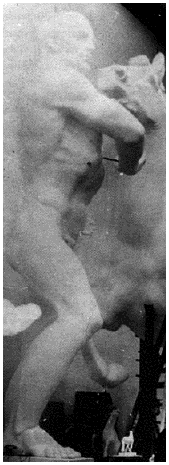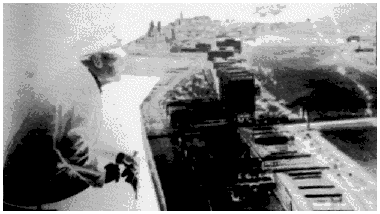In the Third Reich
Jonathan Petropoulos
(University of North Carolina)
-
Conventional wisdom maintains that the arts exert a humanizing and ennobling influence...[but] the obverse of this formulation does not always hold true --- paintings on one's walls do not invariably denote healthiness --- the [Nazi] elite offer a case in point. They represent the union of barbarism and culture.
 Most of us had heard stories of Hermann Göring's thievery of art from the various museums of conquered Europe during WWII --- but we never imagined how far that thievery extended. Every top official of the Nazi party participated in this rape for his own personal gain. Petropoulos says that official figures compiled by the allies at the end of the war listed 249,683 artworks stolen from France, Tyrol, Poland, Russia, Austria, the Baltics, the Benelux countries and, of course, from murdered or deported Jews. But in The Battle of the Louvre, Matila Simon states that the figure should be closer to 400,000.
Most of us had heard stories of Hermann Göring's thievery of art from the various museums of conquered Europe during WWII --- but we never imagined how far that thievery extended. Every top official of the Nazi party participated in this rape for his own personal gain. Petropoulos says that official figures compiled by the allies at the end of the war listed 249,683 artworks stolen from France, Tyrol, Poland, Russia, Austria, the Baltics, the Benelux countries and, of course, from murdered or deported Jews. But in The Battle of the Louvre, Matila Simon states that the figure should be closer to 400,000.
All this governmentally sponsored sacking took place in the course of eight years, and Göring was but one of the malefactors. Hitler himself ended up with over 5,000 rare paintings, sculptures, and tapestries. Joseph Goebbels had the third largest collection, and von Ribbentrop boasted an enormous selection of paintings, including those of Cranash's "Suicide of Lucretia Borgia," Courbet's "Village in the Valley" and "Model in Green," and works of Moreau and Watteau de Lille. Even the brutish Hans Frank, the much-feared Gauleiter of Poland, had Rafael's "Portrait of a Young Man," da Vinci's "Lady with an Ermine," Rembrandt's "Breaking Storm" and "Portrait of Martin Soolmans" hanging on his walls --- along with a rich collection of "tapestries, bronzes, coins, armor, porcelain, antique furniture, manuscripts, and antiquarian books."
It was the lust of thievery pure and simple and, according to Petropoulos, in this closely worked (and excellently researched) book, was put in place not only to humiliate the conquered, but to show that the Nazis were men of culture. It was their way to prove that they were more than street brawlers and bierstube fighters. Indeed, it was a means of competing with, and humiliating, the nobility of Germany, the princes and counts and viscounts --- most of all, the Prussians --- who they loathed.
There came into being an elaborate gifting system that went back and forth between the Nazi leaders, a stylized method of showing rank and power. (It was also a hell of a good way to make money: art works would be bought with the debased currency of the conquered nations, and then resold in Germany for stunning profits.)
Petropoulos has not just written a book about stolen art, he sees this art --- and its fate --- as symbolic of the structure of Nazi culture:
Hitler openly aimed his intention to pervert the very meaning of the concept of culture by mobilizing it for its own power...The Nazi leaders used art as a means of expressing power --- to convey what they perceived as personal, factional, national, and racial preeminence...[They] were skilled at theatre politics. In their own way, they were masters of gestures and symbols. They communicated their ideas and fantasies by way of a coordinated propaganda campaign, which they themselves also came to believe.
For those interested in the beastly soul of the Third Reich, this is a powerful and revealing tale. The author has a way of interlarding facts of which artworks ended up in whose hands with personal vignettes of these very peculiar men. Indeed, the final image that we are left with --- a repulsively engrossing one --- is a picture of Hitler, in his last days, in the Berlin bunker complex, sitting, spent, under a portrait of Frederick the Great, the two of them brooding over a giant model, designed by Albert Speer, of a proposed cultural complex in Linz, that would be built "once victory comes about." Pertopoulos writes,
One is left with the haunting image of Hitler sitting for hours on end in the model room of his bunker during the last days of the war, dreaming of the museum, concert halls, and monuments of the new Linz...That Hitler's plans for Linz and the picture of a king could sustain him at this hopeless point serves as a testament to his capacity to be captivated by dreams and symbols. It is an extraordinary aspect of the Third Reich that the world articulated in this way was, for many years, in fact the reality.
